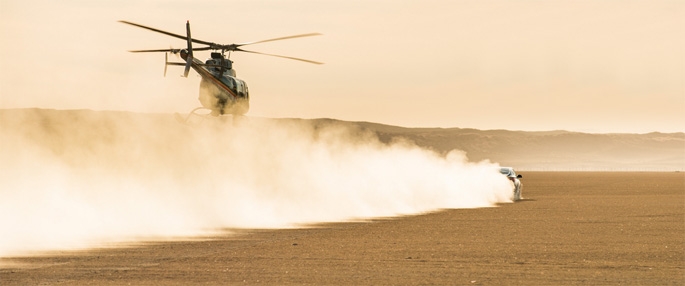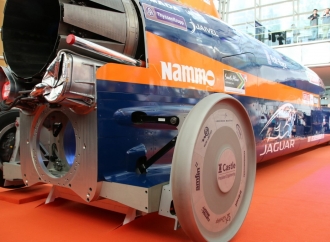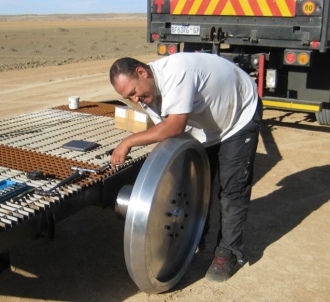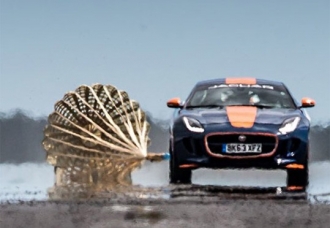
It’s still 9 months until October, when we plan to have BLOODHOUND SSC running in South Africa, and there is a lot to do between now and then. It’s not just the engineering required to run at high speed: in some ways, getting the Car ready is the easy bit. We’ll be testing the Car with the jet engine only, so our ‘BLOODHOUND 500’ vehicle will not be much different to the Car we ran last year in the UK.
In simple terms, all we have to do is install the desert suspension and high-speed metal wheels, fit the remaining bits of bodywork and add a couple of high speed brake parachutes at the back end of the Car. There’s some internal systems work to do, like connecting up the rest of the sensors (including nearly 200 pressure sensors, so it could take a while). Still, once that’s all done, we’re pretty much ready to go.
 You can’t just chuck them on
You can’t just chuck them on
Before engineers everywhere start shouting at me, I know it’s not quite that easy. At our target of 500+ mph, the wheels will be rotating at over 5000 revolutions/minute and the wheel rims will be experiencing loads of well over 12,000 times the force of gravity – in other words, a lot. The safety of the Car is critically dependent on things like the mounting, balance and security of these wheels. Just ‘chucking the wheels on’ isn’t going to cut it.
This is precision engineering of the highest order and we need to get it exactly right, but that’s pretty much routine stuff for our brilliant team of engineers. It’s a big job, but they’ll get it done.
 Segrave, making it look easy
Segrave, making it look easy
While preparing the Car may sound easy, I don’t want to under-estimate the scale of this year’s task. Looking back through the history of the sport, 1929 is probably the last time anyone made it look easy, when Henry Segrave set the World Land Speed Record at 231 mph in the beautiful ‘Golden Arrow’. Segrave drove his car for the first time in February 1929, with a couple of trial runs on Daytona Beach in Florida. A few weeks later, he did 2 more runs to set a new World Record. Job done, back home in time for tea and medals.
Record breaking has got more difficult since then. Once the Car is ready, our first task will be to transport BLOODHOUND SSC and all its support equipment to our desert track in South Africa. Let’s assume that everything moves on time and as planned (it won’t). Let’s also assume that all the paperwork, export licences, etc., are all perfect and accepted first time (they won’t be). That gets us to Upington airport, ready for the 250 km road move north to our test track.
When the Car finally gets to Hakskeen Pan, we have to set up a high-tech engineering and operations base, on a desert 5000 miles from home, to run the World’s most sophisticated Land Speed Record Car. Looking at all these tasks, and a number of others I haven’t mentioned (so that I don’t scare myself too much), our first desert visit will be an invaluable rehearsal for future record breaking.
Now comes the good bit. While we are on the desert, we will learn a huge amount about the Car during this year’s ‘BLOODHOUND 500’ Adventure. Our target of 500+ mph is aiming to get us over half way to our final target of 1000 mph. In getting to over 500 mph, we will test the Car at ‘slow speed’ (up to 200 mph) on the desert and at ‘medium speed’ (200-500+ mph). The reason for highlighting 200 and 500+ mph is that interesting things happen between these speeds, as a result of how the wheels work and how the aerodynamic forces build up.
Below 200 mph, the aerodynamics forces are minimal, as they are proportional to the square of the speed. That means that at 100 mph (1/10th maximum speed), the forces are (1/10 x 1/10 =) 1/100th, or 1%, of maximum aerodynamic force. In other words, nothing worth mentioning.
On the other hand, the metal wheels provide maximum grip at low speed. Of course, maximum grip on the desert is low, with a coefficient of friction of about 0.2, based on previous experience. That means that a 100 kg load would require 20 kg of force to slide it along the surface. That’s about the same level of grip as a normal road car driving on snow. Yikes. That’s not a great way to start a high speed run.
 Better than being on snow…
Better than being on snow…
To increase the lateral grip of BLODHOUND’s desert wheels, each wheel rim is a rounded-off V-shape, which will cut into surface (by about 8 mm) to resist sideways movement by providing extra lateral grip. This works well, as we found out during tests back in 2012. At slow speed, the lateral grip of these V-profile wheels is about 0.3-0.4 (worse than a road car in the pouring rain, but it’s better than being on snow!).
Now the down side. As BLOODHOUND accelerates over 200 mph, the V-shaped wheels will start to ‘plane’ on the surface like high speed boat hulls. At 500 mph the wheels will only be penetrating the surface by about 5 mm, greatly reducing the lateral grip. This will give a reduced steering response and a tendency to drift sideways in crosswinds. At this point, it will feel like I’m driving on ice.
On the plus side, the aerodynamic forces increase rapidly with the square of the speed. As we approach 500+ mph, this should start to control the directional stability and make it much easier for me to keep the Car straight. Of course, as the wheel effectiveness falls off quicker than the aerodynamics kick in, the Car’s directional stability will hit a low point somewhere between 200 and 500 mph (we can’t be much more accurate than that – there are too many variables).
One of the key things we’ll learn on the desert in this ‘BLOODHOUND 500’ year is how to control the Car during this critical speed range. This is essential preparation for next year’s runs, as the Car’s rocket will be firing somewhere near this minimum-stability point, so we need to be able to control the Car effectively at this speed. After that, everything should get easier (I hope…).
The other key thing we will test this year is the brake parachutes. In aerodynamic terms, these are probably the most complex devices on the Car. That might sound surprising, but it’s true. A brake chute is a completely flexible aerodynamic device, operating in turbulent airflow, and its deployment is (mathematically) ‘chaotic’ which causes it to be different every time. I recently read a research paper which described parachute modelling as ‘a nonlinear, nonstationary problem of aeroelasticity, the mathematical solution of which presents outstanding difficulties’. Quite so. The paper goes on to say that ‘the problem has not been fully solved’. That’s why the brake chutes are just about the only things on the Car that we can’t model with a computer.
 Slow speed chute test
Slow speed chute test
Even if you’re NASA, producing a reliable brake chute system requires a fair bit of development testing (a technical term for ‘trial and error’). We’ve already tested the basic chute mechanism at over 100 mph, now we can complete the process at 500+ mph.
Until the chutes have been tested and proven, we can’t rely on them. Indeed, pretty much every Land Speed Record Car I’ve studied has had a chute failure at some stage, so for these first test runs we’ll make sure that we have plenty of room to stop, without the chutes if necessary. This could be the major factor that limits our speed this year, but I’m still betting we’ll get comfortably over 500 mph.
A final thought on Henry Segrave making things look easy in 1929. At the same time, on the other side of the world, Malcolm Campbell was finding things very difficult. He had been in South Africa for months, preparing ‘Blue Bird’ to set a record of 215 mph. Just a few weeks before the car was ready to run, Segrave smashed the Record at 231 mph. No tea and medals for Campbell, who failed to get his Outright World Record in South Africa. Perhaps that’s why everyone in South Africa is so excited that BLOODHOUND is coming – there’s some unfinished business to take care of.


